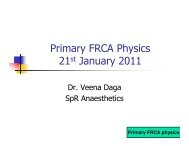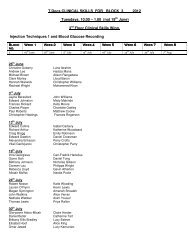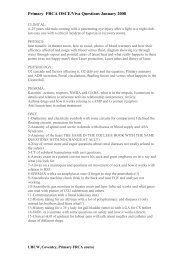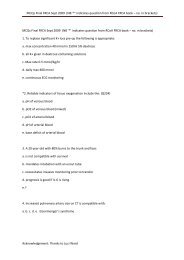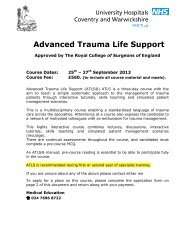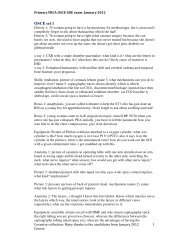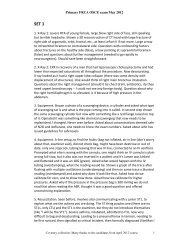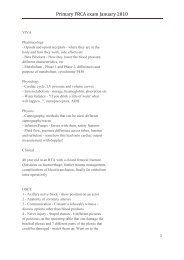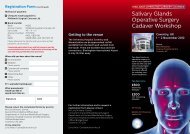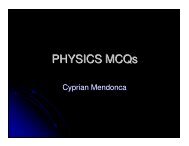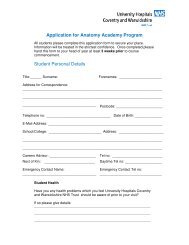ACS (ED, CDU, OBS) - Mededcoventry.com
ACS (ED, CDU, OBS) - Mededcoventry.com
ACS (ED, CDU, OBS) - Mededcoventry.com
- No tags were found...
Create successful ePaper yourself
Turn your PDF publications into a flip-book with our unique Google optimized e-Paper software.
What is <strong>ACS</strong>?Acute Coronary Syndromes are a group of conditionsrelated to Coronary Heart DiseaseThey vary from stable angina to myocardial infarctionCHD<strong>ACS</strong>Stable anginaSTEMINSTEMI+Unstable angina
What is <strong>ACS</strong>? Cont ...All types of <strong>ACS</strong> have a <strong>com</strong>mon aetiology in the formation ofthrombus on an inflamed and <strong>com</strong>plicated plaque
Structure Of Thrombus In <strong>ACS</strong>There are similar presentations with each type of <strong>ACS</strong> but treatmentand investigation with vary due to the type of plaque formationUA/NSTEMI:Partially-occlusive thrombus(primarily platelets)ST ↑ MI:occlusive thrombus(platelets, red blood cells, and fibrin)Intra-plaque thrombusPlaque coreIntra-plaque thrombus(platelet dominated)Plaque core(platelet dominated)SUDDENDEATH
<strong>ACS</strong> Presentation• About 600,000 patients per annum attend EmergencyDepartments in the UK with chest pain– Of these, 25% have <strong>ACS</strong> .– Symptoms on presentation include:•Dis<strong>com</strong>fort/pain in the centre of the chestthat lasts for more than a few minutes orrecurs•Dis<strong>com</strong>fort/pain radiating to other arease.g. arms/legs/ jaw/neck/back/stomach•Breathlessness•Tachycardia•Nausea or vomiting•Sweating and clamminess
Pain areas associated with MI/<strong>ACS</strong>Usual distribution of pain with myocardialischaemiaLess <strong>com</strong>mon sites of painwith myocardial ischaemiaRight sideJawEpigastriumBack
The ECG In <strong>ACS</strong>The ECG in <strong>ACS</strong> is the vital <strong>com</strong>ponent in determining how the chestpain is treated and then managedAn ECG should be performed within 10 minutes of the patients arrivalin <strong>ED</strong> or after the onset/reporting of an episode of chest painA pain free ECG should also be taken and on admission to a new wardareaEach ECG needs to be seen/reviewed as soon as its taken – Reviewsshould be undertaken by the on duty CNP / Doctor or if unavailable amember of CCU / Catheter LabNOTE – ECGs can change – just because the initial ECG is notdiagnostic DOES NOT mean that the repeat won’t be!!!!
ST Elevation Myocardial Infarction(Lateral / Posterior)
ST Elevation Myocardial Infarction(Anterior)
ST Elevation MyocardialInfarction (Inferior)
ST Depression
Dynamic T Wave Inversion
A Reminder as to theImportance of the RepeatECG
Initial / Presenting ECG
The Repeat ECG
Pharmacological Managementof <strong>ACS</strong> Initial Management of all <strong>ACS</strong> patients MONA Morphine Oxygen Nitrates Aspirin 300mg STEMI Patients (in Primary PCI) MONA plus Clopidogrel 600 mg
Pharmacolgical Management Cont ...Unstable Angina / NSTEMI MONA plus Clopidogrel 600mg Enoxoparin 1mg/kg BD ACE Inhibitor (eg Ramipril) Beta Blocker (eg Bisoprolol) GTN (PRN)In Patients with ongoing Chest pain expect an IV GTNinfusionIn Patients with ongoing chest pain and ECG changes alsoexpect Tirofiban and expedition to Catheter Lab andCoronary Care
Nursing ManagementTimely Pain management as prescribedCardiac MonitoringRegular (min 4hrly) observationHourly in <strong>ED</strong> or if on GTN infusionECGs when and ECG interpretation whenpatient in PainPOST pain releifon admission to <strong>ED</strong>/wardDailyOn DischargeBloods and Troponin Markers @ 6hrs / 12hrs post pain (as documentedby Drs or CNP)Report Ongoing pain to Doctors or CNPLimit Mobilsation – Do not let UA / Trop +ve patients mobilise freely(limit to bedside, bathroom, no showers UNLESS >24hrs pain free)
Any questions????



